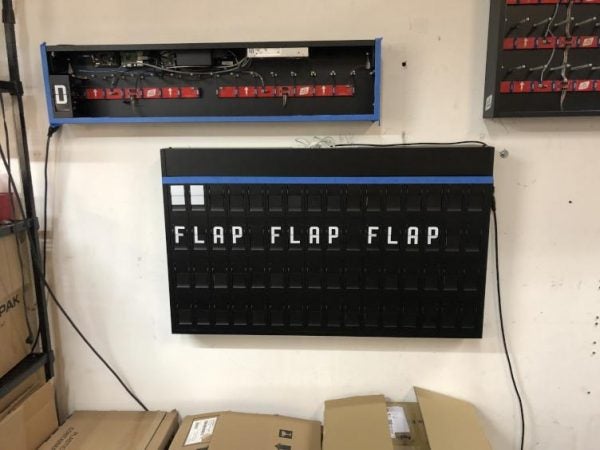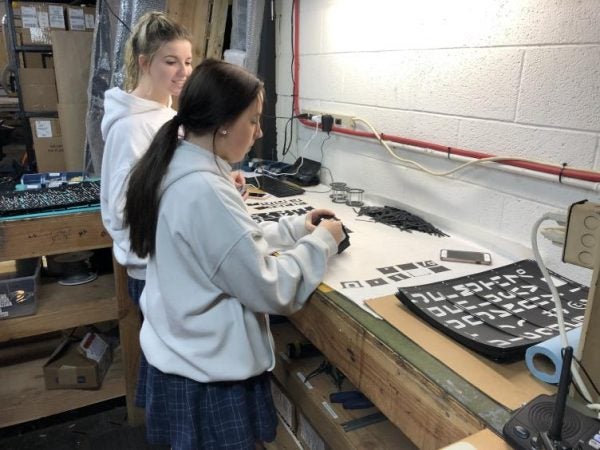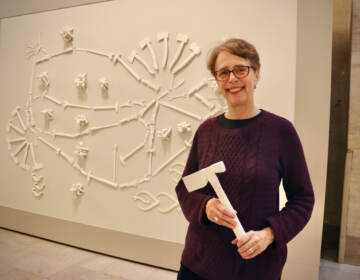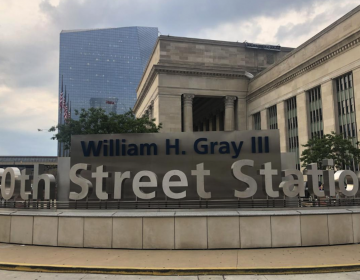Drexel grads pitch Amtrak on new sign: Vintage-style romance with efficiency of new technology
Amtrak appears intent on following through on its plan to install digital screens and send its Solari board to a museum.
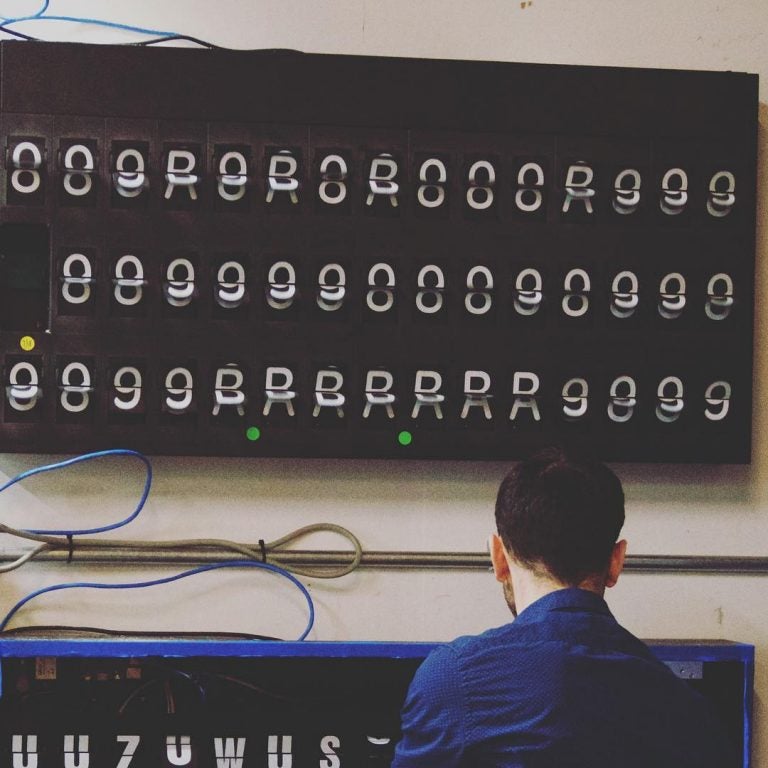
A split-flap board made by Oat Foundry. (Provided)
This article originally appeared on PlanPhilly.
—
As Philadelphia mourns the pending loss of Amtrak’s beloved clackety departure board at 30th Street Station, one local business has stepped into the fray with a bold proposition.
“We would love to build a new board for Amtrak,” said Mark Kuhn, CEO and co-founder at Oat Foundry, a five-year-old engineering design firm founded by a group of Drexel University grads. “We’ve sent a couple notes out to the Amtrak folks and we’ll see what happens.”
Oat Foundry is the only company in the U.S. that continuously designs and manufactures the old-school split-flap displays.
Kuhn acknowledges that the rail agency is unlikely to take him up on the offer. But he thinks that the groundswell of appreciation for the vintage technology may sway Amtrak to at least take a look at his company’s pitch.
“What I’m hoping is that Amtrak responds to some of this romance and says, ‘we are hearing what you’re saying, and Oat Foundry makes this great and very affordable solution. Let’s put one in the lounge, let’s put a couple in the concourse.’ It doesn’t necessarily have to be transportation information,” Kuhn said.
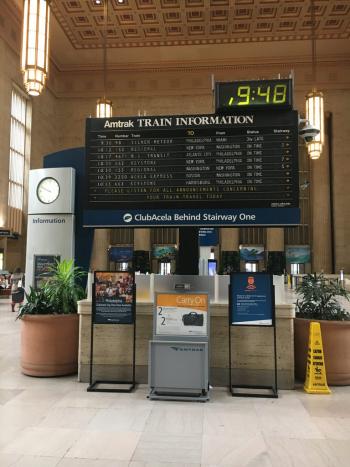
Most of the company’s boards are in restaurants, hotels, and offices, where they straddle the line between art and information. They cost a few thousand to tens of thousands of dollars apiece, depending on their size and degree of customization. The team designed their first one in 2015 at the request of the Philadelphia-based chain Honeygrow. The salad and stir-fry spot wanted to show order numbers and other messages in a way that wouldn’t “over-tech” its restaurants, where customers already use screens to order.
Oat Foundry has since sold more than 50 of the devices to a variety of clients, including the new Shakespeare & Co. on Walnut Street, a bar at Chicago’s Wrigley Field and a museum in Azerbaijan. The vintage-styled signs grace three Starbucks cafés in Mexico and Central America and corporate offices in Hong Kong and England.
If Amtrak took Oat Foundry up on its offer, the 30th Street board would be the company’s first train station commission.
It would not, however, be the firm’s first departure board.
For Nolita Hall, a bar that sits in the flight path of San Diego International Airport, Oat Foundry created a novel take on the travel icon, integrating flight data into a display.
“The whole ceiling is a skylight, and you can see the bellies and the tails of these landing aircraft. Our split-flap sign queries a flight tracker API, pulls real-time flight tracker data, and puts it on the sign,” Kuhn said. Along with beer and cocktail specials, the huge sign behind the bar shows “what plane is landing, when it’s landing, where it had taken off and what airline.”
The flip display is Oat Foundry’s main product, but the company has also built an industrial-scale coffee brewing machine, a plant specimen scanner for Morris Arboretum, and other custom engineering projects.
Last November, one of the displays did make a brief appearance in 30th Street Station. On this occasion, the romance was highly calculated. Instead of announcing train delays, the miniature display helped a man propose to his girlfriend. Kuhn stood nearby and used his phone to change the sign to, “She said yes!”
Split-flap displays were invented by the Italian company Solari Udine in the 1950s and were widely used in train stations and airport terminals for decades. They’re rare now, but they’re still associated with the drama and suspense of travel. Part of that association comes from the flurry of rapid flapping sounds that announces the launch, or delay, of a journey.
Kuhn attributes the signs’ popularity in part to their mid-century modern design vibe, an aesthetic that has surged in popularity as of late. They’re also examples of
the mechanical aesthetic that gave way to the era of ubiquitous televisions, and now, digital screens.
“People like it because it’s complex and because it’s real,” he said. “It’s very tactile and engages, at least, the auditory senses and visual senses.”
“How it works is sort of just beyond the realm of standard comprehension,” Kuhn explained. “You know that there’s motors in there, you know that there’s gears of some kind or belts of some kind, and flaps. But the fact that it’s so many going at once — it has this enormity to it that is enticing and romantic.”
The three-dimensional, moving displays provide respite from the computer monitors and phones that are continually shining information at our faces, he said.
“Every day we’re inundated by screens. If I asked you, how many screens have you seen today, it’s an impossible question to answer. You wake up, you look at a screen. You’re at your laptop all day. Your car now has a screen in it. You passed dozens on the way to and from wherever you’re headed. Even billboards now are screens. There’s some kind of fatigue component with that. It doesn’t matter what’s on the screen really anymore. You don’t want to look at it,” Kuhn said.
He contends his company’s boards provide the best of both worlds: the allusions to train stations and to mid-century design and engineering, and the convenience of control via a cell phone or computer.
“You get to retain that nostalgia, but you don’t have to subscribe to some kind of big transportation background or technical background,” he said.
Nonetheless, Amtrak appears intent on following through on its plan to install digital screens and send its Solari board to a museum. Smaller split-flaps at each track stairway will also be replaced. The agency announced two years ago that it would replace the displays as part of an ongoing rehab of 30th Street Station that is costing hundreds of millions of dollars. It replaced a similar board at New York Penn Station last year.
Amtrak says a new screen will comply with the Americans with Disabilities Act, make 30th Street “more modern and tech-friendly,” and allow flexibility for future technology upgrades. The current board is controlled by computers running Windows 95 and has been known to fail for months at a time. Also, spare parts are scarce. A spokesman said in an email that Amtrak never considered upgrading its split-flap display, and declined to say whether the agency had talked to Oat Foundry.
“They’re going to get a big screen. That’s a foregone conclusion,” Kuhn said.
Kuhn noted that Solari boards are still used at some transportation hubs, including the Trenton Transit Center, which serves SEPTA, NJ Transit and Amtrak. There are reportedly working split-flap displays at the Atlantic City train station and the airport in Jacksonville, Florida. The San Francisco Ferry Building is the rare U.S. transportation center that replaced its old sign with a new split-flap board, installing an Italian-made unit in 2013. The mod displays also remain in use at a number of station and airports in Europe and Asia.
WHYY is your source for fact-based, in-depth journalism and information. As a nonprofit organization, we rely on financial support from readers like you. Please give today.




